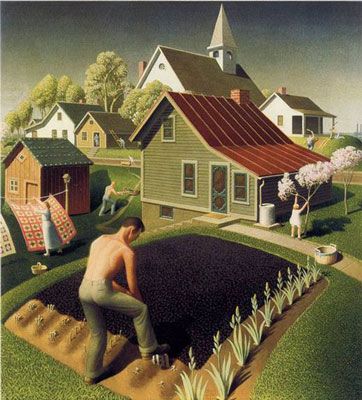Summary of John Steuart Curry
During the Great Depression, John Steuart Curry devoted himself to painting sincere portrayals of the American heartland. At a time when critics were calling for an American vernacular art and the discovery of a usable past, Curry and other Regionalist artists headed the call to paint rural and small town America. These often idealized, even nostalgic, depictions of community, religious life, and indomitable work ethic aimed to provide solace to a populace suffering the effects of a financial disaster and widespread drought.
Recognized during his own time, along with Thomas Hart Benton and Grant Wood, Curry painted easel paintings as well as murals that decorated various government buildings. Unfortunately his more traditional style of painting did not sustain his reputation after his death, and Curry remains an often overlooked American painter.
Accomplishments
- In using allusions to Classical and Renaissance art, Curry imbued his subjects with a gravitas and importance that other depictions of rural life often lacked. He aimed to create timeless narratives that evoked moral authority and would inspire the people.
- While Curry typically depicted bucolic scenes, many of them have a questioning, even sinister, quality about them that adds a complexity to otherwise straightforward depictions, but which led some to criticize him for misrepresenting folks in small Midwestern towns. This disquieting aspect of his work, though, might be seen as a commentary on rural American life and as a more multidimensional take on Regionalism's preferred subjects.
- Criticized for his technical awkwardness and not producing a stronger, identifiable style, Curry nevertheless gave vision to an expressive regionalism that often embodied the dynamism and spirit of rural communities.
Important Art by John Steuart Curry
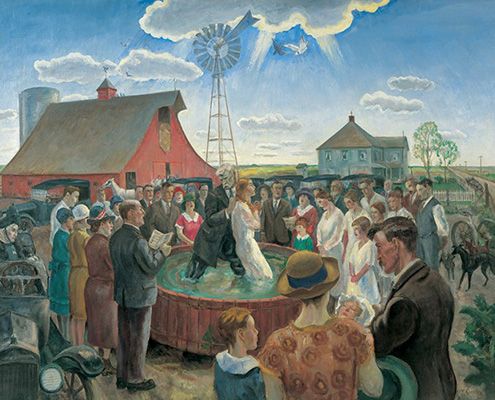
Baptism in Kansas
Baptism in Kansas was Curry's first major success, produced soon after his return from Paris and depicting a scene recalled from his childhood. During one of the region's many droughts, Kansas communities in 1915 found themselves having to use farmyard water-tanks for baptisms. In the center of the painting, the local pastor baptizes a blonde, white-robed woman. The service is watched by the entire community - families, farmers, policemen, and animals alike. The concentric, spiral-like composition of the scene leads the eye from a partially depicted automobile in the bottom left to the spectators with their backs to the viewer in the foreground, over to a group of soon-to-baptized dressed in white, circling around the tank to a gentleman holding a hymnal, and finally ends with the pastor and young woman in the center. Beyond the spiral of people one sees the buildings of the farmstead and the vast landscape beyond. The sky beams with sunlight, and the fields and roads stretch into the distance, while Noah's dove and raven fly over the scene. The painting is epic and intimate at once.
The subject of the painting - religion, rebirth, and community ethics - was common to Regionalism, as it rejected urban cosmopolitanism in favor of heartland realism. The triangular composition of the priest propping up the woman's body mirrors the timber structures of the sturdy farm-buildings, celebrating the strength of core American values and institutions. The motor-cars, a symbol of 1920s capitalism and urban youth, are relegated to the outer fringes of the frame in favor of a vocal community chorus.
Present also are the beginnings of Curry's unique compositional style and his feel for expressive potential. The combination of the dominant spiral formation and multiple triangular shapes - the priest's legs, the perspective lines of the road and fields, the roofs, the sunbeams - create a tension between a sense of activity and motion and stability. As art historian Henry Adams explained, Curry's composition "simultaneously expresses claustrophobia and agoraphobia."
Oil on canvas - Whitney Museum of American Art, New York
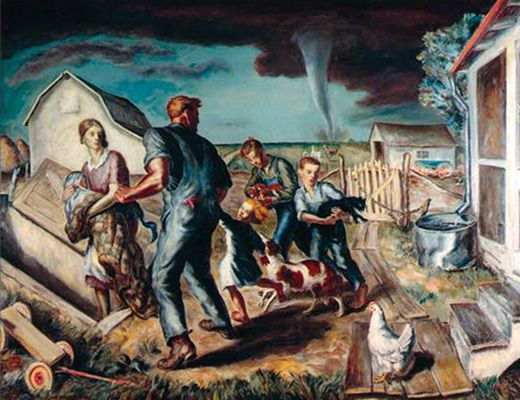
Tornado Over Kansas
"It was action he loved most to interpret: the lunge through space, the split second before the kill, the suspended moment before the storm strikes," said Grant Wood of his fellow Regionalist painter, Curry. Nowhere is this more apparent than in this gripping, muscular scene, where a tornado screams towards a Kansas farm. The family hurries for shelter across the foreground. The buildings and the people seem to tilt and lunge in tense, expressive motion within the frame, reminiscent of the falling figures of a Paolo Veronese painting. Careful, emotionally charged details like the basin for catching rainwater, the expression on the eldest son's face as he carries the piglets, and the patchwork textures of the infant's quilt are offset by the biblical power of the tornado's swirling arm, driven hard into the Kansas earth from a dark sky. The family moves to the left of the frame, towards the light-source and away from the gathering shadow.
This work earned Curry second-prize in the Carnegie Institute's Thirty-first Annual International Exhibition of Paintings, confirming his position as the foremost emerging painter of his day. It's a canvas of extraordinary power, both for its narrative thrust and its emotionally rich composition. Its turmoil and turbulence could also have a biographical reference, as Curry's own marriage at the time was uneasy. Curry's style here, too, is wrought from instability. Though it's figurative and peopled, art historian Henry Adams sees this painting as being right on the edge of abstraction, writing "With its distended figures and exploding buildings, the work appears to threaten to transform itself into a synthetic cubist composition. Traditional composition has here been pushed to an expressive limit, has come to the verge of becoming something completely different."
Oil on canvas - Muskegon Museum of Art, Michigan
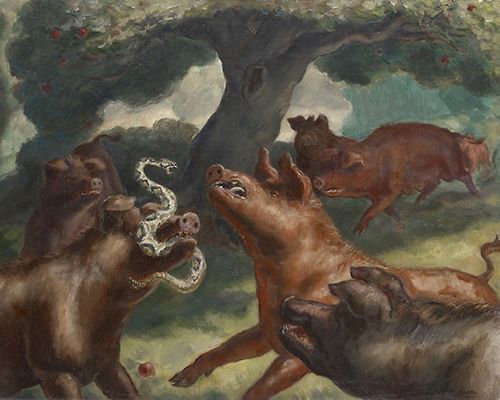
Hogs Killing a Rattlesnake
Curry is best known for his powerful, socially and historically located canvases and murals - paintings of actual people, real communities, and tangible geographies. Often there is a phantasmagorical feel, an electricity in the air, a pseudo-Biblical power. But we're usually aware of who, when, and where we are. Sometimes, however, as in Hogs Killing a Rattlesnake and the later painting, Ajax, Curry moves into a rarefied space of ambiguous, allegorical expressiveness. Here, seven furious hogs converge from all sides of a woodland glade upon a doomed rattlesnake. The power of the hogs is noisy and total. One pig looms into the frame from the foreground, making a viewer feel compelled forwards with bestial energy, even complicit in the hunt. The snake rears and bares its fangs bravely, its twining musculature seeming unreal, unlike anything else in the forest scene. Curry dashed and stroked his paint with more blur and vigour than usual, even scratching the canvas with his fingernails to give the coarse and hairy effect on the boars' hides.
The tree's canopy bears ripe, red fruit, one of which has fallen plump to the ground, suggesting fertility and life even amongst the throes of death. Curry's flair for capturing facial expressions is here transferred from people to hogs. Their snarls and focussed eyes exude personality and power, and the snake, too, has a voice. Violent and verdant, composed around the dark hole in the tree's trunk at the painting's center, the painting communicates a vital sense of the world's natural forces, its pounding rhythm and thrilling energy celebrates the pulse and cycle of life and death.
Oil on canvas - The Art Institute of Chicago

Ajax
"The / soot-brown tail-tuft on / a kind of lion-/tail; what would that express? / And John Steuart Curry's Ajax pulling / grass - no ring / in his nose - two birds standing on the back?" Marianne Moore's 1932 poem, The Buffalo, pays tribute to Curry's colossal ox, Ajax. Named after the mythical Ancient Greek warrior, nemesis of Hector and survivor of the Trojan War, Ajax the cow is a figure of epic scope and stature. He stands here, utterly dominant, upon his own hermetic patch of earth, backdropped by rolling plains, and framed by a cumulus, billowing cloud. The heavens and the earth conspire to frame his power. As Moore observes, his nose is un-ringed - he is an untamed bull, all the more imposing because of his calmness and poise. He is almost geological, continental, in his size. Two cowbirds warble around on his indifferent back. Curry's friend and contemporary, Reginald Marsh, quipped that this painting was secretly a self-portrait. Curry was a stocky, athletic man, but Marsh is probably also referring to the fact that most of Curry's mature paintings mix a broad geographic sweep with a profound, internal tension.
Curry of course here occupies Grant Wood's Regionalist ideal - "a feeling for one's own milieu and for the validity of one's own life and its surroundings" - but reaches beyond to deconstruct epic myth through the starkness of the present moment. His face, four legs, and tail are rooted firmly in the American turf, but the sheer statement of his presence is timeless and placeless. Marianne Moore was a poet at the forefront of the high modernist movement, so her reference to Curry, the traditional Regionalist, is perhaps surprising, but points to Curry's strange and singular power, his unique positioning in the modern age as a small-C conservative with a modernist's sense of complexity, form, and contemporaneity. The language of Ajax is firm and absolute, but its possibilities and meanings refract through the ages.
Oil on canvas - Smithsonian American Art Museum, Washington DC
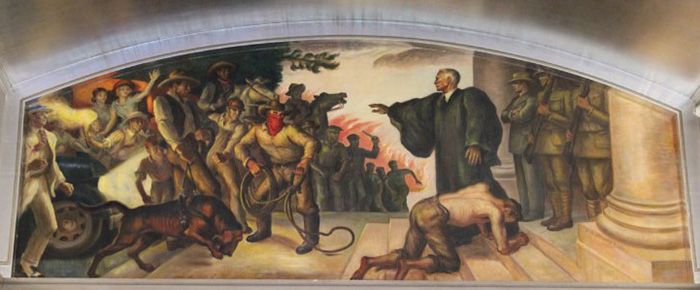
Justice Defeating Mob Violence
In this mural, created for the Justice Department as part of the Federal Arts Project, Curry presents a stark narrative depicting a crazed lynching mob and the powerful forces of justice. He uses classical figurative elements to communicate the allegorical power of the judge in holding off the oceanic forces of the mob. In the center, a masked man holds a rope, as if prepared to snap it into action, but in the left foreground, an angry dog and a blaring automobile form the most threatening element of the crowd. Included in the crowd is an unlikely man dapperly dressed in a linen suit and two young women waving their hands and taking in the spectacle. While primarily allegorical, this sinister depiction of a certain American mindset belies the more bucolic and idealized versions of rural America that Regionalists depicted.
The figures in the mob are crouched and aggressive, their poses mirrored by the submissive posture of the accused man, who crawls, bloodied, onto the steps of a courthouse. He has been reduced to an animal, or perhaps it is the mob who are dehumanized by their own actions, reeling into an indistinguishable mass in the center-background, engulfed in flame that is more hellish than it is purgative. The judge bears a serene expression on his face, every bit as monumental in his pose as the Neo-classical pillars of the courthouse behind him. His palliative, controlling arm is mirrored by the bough of peace in the top-center of the frame. The mask of the central figure along with the shadowed faces of the other figures suggests the impersonality and senselessness of mob-rule.
Art historian and Curry champion Lawrence Schmekebier described this painting as "not a symbol...but a universal situation, valid in the past as it will be in the future." Schmekebier identified Curry's penchant for slipping beyond immediate circumstance into something like Messianic Time, where past, present and future seem to occur simultaneously. The mob is a mob for the ages, the judge a figure of Absolute Justice.
Oil on canvas - Robert F. Kennedy Building, Department of Justice, Washington DC

Tragic Prelude
Curry's epic panel for the Kansas Statehouse mural shows the towering figure of John Brown, the militant abolitionist leader who abhorred slavery and fought violently against Confederate forces during the American Civil War. Wind and fire reign over a Kansas horizon beyond him. Farmers and cattle traverse the prairies, re-purposed as soldiers and beasts of war. Forces from the Union and the Confederacy clash in the middle-ground, as Brown tramples opponents underfoot. An African American family can be seen, caught among the Confederates.
Curry's depiction of Brown is visceral, but also nuanced. Many saw Brown as a hero, others branded him a murderer and a terrorist. After Brown was sentenced to death for murder, the Transcendentalist writer, Ralph Waldo Emerson, said he would "make the gallows glorious like the Cross," and so Curry paints Brown in a stark and monumental cruciform, bellowing to the sky. Brown the soldier-prophet brandishes a bible and a rifle. There is blood on both of his hands. Curry paints an Old Testament fury into his figure, giving the painting a visionary power alongside its brutal violence. This painting is enduringly relevant as an exploration of the tensions at the core of American national identity.
Curry himself felt torn between his beloved but backward home of Kansas and the more cosmopolitan life he led while studying in New York and Paris, and this ambivalence perhaps found its way into his work with exaggerated and threatening figures. Citizens and officials in Topeka, the Kansas Capital, were critical of Tragic Prelude, worrying that tornadoes and prairie fires showed the state as stereotypically wild and dangerous, that the blood on Brown's hands portrayed him as the murderous lunatic that some historians believed him to be. The menacing and ominous overtones, which were not uncommon in Curry's work, often met with confusion and even dismissal, thus complicating his legacy. In this instance, Curry stormed out of Topeka and left the mural unfinished and unsigned. Despite this rejection, the painting survives as an important moment in the country's history, a complex commentary upon America's past and potentially its future.
Oil and egg tempera mural - Kansas State Capitol, Topeka
Biography of John Steuart Curry
Childhood
In 1897, John Steuart Curry was born on a farm in the unincorporated community of Dunavant, Jefferson County, Kansas. According to a 1910 census, the town had a population of 85. He was the eldest child of Thomas Smith Curry and Margaret Stueart, both of whom were raised on mid-western farms but had been college educated. While the young painter would often do farm-work for several hours before heading into town for school, he could just as often be found in the fields sketching horses and buildings instead of shovelling manure.
His mother and father were also distinguished in their community by the fact of their having honeymooned in Europe, visiting Paris. Significantly, Margaret brought back souvenir reproductions of famous paintings. Curry later remembered, "Instead of grain and feed calendars in our house...we had Rubens, Bellini and Millet. That was unusual and had a great deal to do with forming my future."
Early Training
Curry attended Winchester High School in Kansas, excelling in football and athletics, but dropped out before graduation in 1916 to attend art school. From 1916, Curry studied at the Art Institute of Chicago and from 1918 to 1919 at Geneva College in Beaver Falls, Pennsylvania. In 1920 he introduced himself to the illustrator Harvey Dunn after eagerly pursuing him to New Jersey. Curry settled in New York in 1921 and worked for four years as an illustrator for magazines such as Boy's Life. His experience as an illustrator heavily informed his later painterly style, particularly his sense of narrative and his bold, centrally-foregrounded figural composition.
In 1923, Curry married Clara Derrick. They met through Curry's brother, Eugene, who worked for Clara's father at the New Jersey State Home for Boys. "Well I am married, happy and glad of it," Curry wrote to his mother. "We had a dandy little wedding." The couple settled in Westport, Connecticut, the next year, and Curry began painting oils and watercolors in his studio. A family of skunks took up residence below the floor of his studio. Curry was very fond of them, and included skunks in his paintings many times in his career.
In 1925 Curry assisted artist James Daugherty on a mural for the Cook Travel Agency. Daugherty was frustrated with Curry's lack of basic technical skills, his inability to complete simple pictorial tasks like painting a flag - but was also struck by the young painter's powerfully unconventional sense of form. He advised Curry to study further at Basil Schoukhaieff's drawing academy in Paris. In 1926 Curry and Clara Derrick left together for France.
During his time in Paris, Curry developed his sketching and his painting. While in Paris, the grains of traditionalist thought that would engender his Regionalist style were planted. He rejected the avant-garde trend towards abstraction represented by Matisse and Picasso, preferring the Old Masters, and he became devoted to Rubens and Titian. Of the modernist artists he said, "They were good but not good for me. Now, at the age of twenty-nine years, I grew up. I discovered my tradition. I discovered Rubens."
Mature Period
Not long after returning from Paris, Curry became an almost-overnight sensation on the East Coast when his painting Baptism in Kansas (1928) was exhibited at the Corcoran Gallery of Fine Arts, Washington D.C., as part of the Biennial Exhibition of Contemporary American Oil Paintings. His unfamiliar rural subject matter, his unconventional spatial perspectives, and his biblically potent narratives captured the minds of contemporary viewers in Philadelphia, New York, and Washington D.C. Another canvas produced around this time, depicting a Kansas family rushing for cover as a twister tears up the horizon (Tornado Over Kansas, 1929), cemented Curry's celebrity. He began to be exhibited regularly in the North East, and in January of 1930 his first solo exhibition opened at the new Whitney Studios Gallery in New York.
His whirlwind success was coupled with turbulence, however. Curry labored with intense emotional and mental strain, and in 1932, he literally ran away with the circus. Leaving his wife, Clara, at home, Curry travelled with the Ringling Brothers and Barnum & Bailey Circus for much of the year. In July, Clara died. "I was twenty minutes too late to see her alive," Curry wrote to a friend.
In June 1934, Curry married his second wife, Kathleen Gould Shepherd, a friend from Westport, and travelled the Midwest making sketches. Also in the early 1930s, thanks to the efforts of William Allen White, a newspaper publisher from Topeka, Curry's paintings began to be exhibited in Kansas and the Midwest. They were less well received here than they were on the East Coast, with White's own wife remarking, "Why paint outstanding freakish subjects and call them the 'spirit' of Kansas?"
Nevertheless, throughout the '30s Curry was considered alongside Thomas Hart Benton and Grant Wood as among the foremost painters in America. These three were featured in TIME magazine and recognized across the nation as ground-breaking artists of the emerging Regionalist movement. They were celebrated for speaking from America's heartland and creating an American painting that resisted European avant-gardism. During this period, Curry produced much of his most recognized work.
Late Period and Death
In 1936, Curry was announced as the Artist in Residence at The University of Wisconsin, a position he would hold for the rest of his career (and in fact, for the rest of his short life). Despite this security, and despite the production of successful and important mural works such as The Oklahoma Landrush (1937), the later stage of Curry's career was defined by the Kansas mural scandal.
In 1936, the Kansas Mural Commission accepted Curry's design proposal for the Statehouse in Topeka. Over the next four years, he produced panels including the famous Tragic Prelude (1937-40), which portrays the abolitionist John Brown as a modern-day Michelangelo's Moses.
By March 1941, State officials and other important figures had objected so much to Curry's murals that there was talk of their removal. The Mural Commission then refused to remove a marble slab from the Statehouse rotunda which was impeding Curry. This decision meant that Curry's original designs could not be completed. The painter abandoned the project in disgust and refused to add his signature to the panels which were already installed.
The controversy brought great strain to Curry's professional and personal life. In 1941 he abruptly severed ties with his friend and associate Maynard Walker of Walker Galleries, who had represented Curry for ten years. Curry wrote, "During the past two years I have become very unhappy and discouraged about the sale of my paintings. I have come to the conclusion that I have done about everything that I can for you, and that you have done about everything you can do for me." Curry signed instead with Associated American Artists. Walker was surprised and hurt, replying, "Maybe I am just plain dumb, but I am still at a complete loss to understand your action".
Despite these controversies, in 1942, Curry was elected to the National Institute of Arts and Letters. In October that same year, Grant Wood died. Curry delivered a tribute to his fellow Regionalist painter, saying "In the years ahead of us Grant Wood's paintings will stand like quiet monuments in their interpretation of that life. No other contemporary artist's work had the unique appeal that Grant's work had....The common man saw in these paintings something that he reacted to."
In November 1943, art historian and close friend of Curry's Laurence E. Schmeckebier published John Steuart Curry's Pageant of America, the first critical and biographical study of Curry's work and life.
On the 29th of August, 1946, John Steuart Curry died of a heart attack in Madison. He was buried in Winchester, Kansas three days later. The Topeka Star reported, "In the golden sunlight of a Sunday afternoon, one of Kansas' greatest artists, John Steuart Curry...came home to be buried in the churchyard of the Reformed Presbyterian Church here. While some 500 of his fellow Kansans looked on to pay him tribute, the noted artist was lowered into a simple grave, marked only by a granite boulder, that over-looked the windmills, barns, and farm homes which he portrayed so often ... A great Kansas artist, who had painted boldly, in vivid and often controversial fashion, was home to stay."
The Legacy of John Steuart Curry
Though he enjoyed much success in his own lifetime and was undoubtably a painter of great power and importance, Curry's legacy is a complex one that is in flux to this day. His time in Wisconsin encouraged a host of rural artists and helped to start an annual art fair, but after his death his reputation has been overshadowed by Thomas Hart Benton and Grant Wood, whose styles were bolder and more idiosyncratic. Certainly, the rise of Abstract Expressionism dampened his reputation even further. Many of the Abstract Expressionists saw Curry and his ilk as political and aesthetical conservatives, representing everything that art should react against. For the younger avant-gardists, art should strive for internationalism instead of regionalism and shake off the yoke of traditionalism. While Curry's native Kansans didn't appreciate his state capitol murals at the time, in the early 1990s, the state senate passed a resolution that "officially recognized the legislature's poor treatment" of the artist, according to the Kansas Historical Society, ensuring his reputation as an important artist. More recent critics and historians have begun to reassess Curry's formal experimentation and his use of multiple perspective points, embracing his technical awkwardness as an important formal innovation.
Influences and Connections

-
![Grant Wood]() Grant Wood
Grant Wood -
![Thomas Hart Benton]() Thomas Hart Benton
Thomas Hart Benton ![Thomas Craven]() Thomas Craven
Thomas Craven- Harvey Dunn
-
![American Regionalism]() American Regionalism
American Regionalism - Illustration
Useful Resources on John Steuart Curry
- John Steuart Curry : inventing the Middle WestOur PickBy Patricia A. Junker (1998)
- Rethinking Regionalism: John Steuart Curry and the Kansas Mural ControversyBy Sue M. Kendall (1986)
- John Steuart Curry's Pageant of AmericaOur PickBy Laurence E. Schmeckebier (1943)
- Renegade Regionalists: Modern Independence of Grant Wood, Thomas Hart Benton, and John Steuart CurryBy James M. Dennis (1997)








